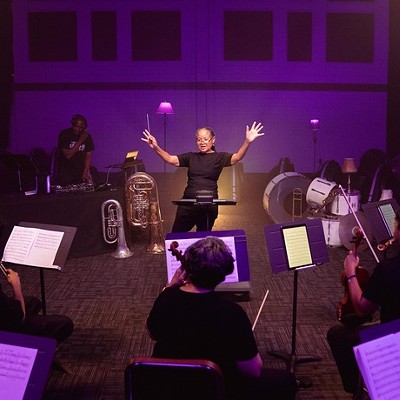If there's one word John Cage is associated with, it's chance. It's crucial to the experience of his signature work, the silent composition 4'33", as well as his process in a variety of mediums.
Cage relied on chance in the composition of both his music and his visual artwork, something he turned to mid-career with his first piece, Not Wanting to Say Anything About Marcel (A + B), which consists of two color lithographs, and explored up until his death in 1992. His very last piece, Extended Lullaby, a neat row of a dozen music boxes, was completed posthumously in 1994. Hiram Butler Gallery has both of these works on display in its current show, a collection of prints, drawings and that interactive music box installation.
Cage was famously known to consult the classic Chinese text The I Ching during each step of his process, whether he was writing a song or making etchings on paper. And though it isn't obvious just by looking at it, this influence is behind the construction of the prints and drawings on display at Hiram Butler. Cage made The Missing Stone, for instance, by asking The I Ching questions on the type of brush he should use, the color paint, the thickness of the brushstroke. The resulting etching is sparse and looks loosely like calligraphy.
A similar process is also behind the making of his "edible drawings" -- paper composed of various herbs and plants. Cage used the book to sort an assortment of herbs into recipes, and through the paper-making process, they were randomly scattered in his drawing. Again, what may come across as deliberate choices are pure happenstance.
Cage almost seems to be taking the easy way out with these drawings, freeing himself of the burden of choice and letting the I Ching make his decisions for him. But in the end, it's a much more laborious process that belies the light, easy manner of the drawings. Plus, Cage has to know what questions to ask in the first place. His seeming non-intentionality makes you think about how many choices go into a single piece of art, as well as all the happy accidents that come about because an artist did something not with intent but rather by mistake. The possibilities are almost paralyzing; consulting the I Ching seems like a pretty good solution.
Chance plays a major role in his music box installation, but rather than rely on an ancient classic text, Cage needs your help to complete the work. In Eternal Lullaby, twelve music box mechanisms are contained within an acrylic tube, each designed to play random notes. With a gentle tap of a lever, you can start the music box's non-melodic tune. You can choose to get as many of these music boxes going as you like (some may need to be wound), but two or three at once gives you a chance to really listen. The resulting lullaby won't likely be one that you'd want to lull you to sleep -- the discordant tones can get pretty eerie -- but sometimes, amazingly, they can strike a pleasant chord -- by chance, of course.
"John Cage: Prints, Drawings, and a Music Box" at Hiram Butler Gallery, 4520 Blossom Street, runs now through March 30. For more information, call 713-863-7097 or visit www.hirambutler.com.





